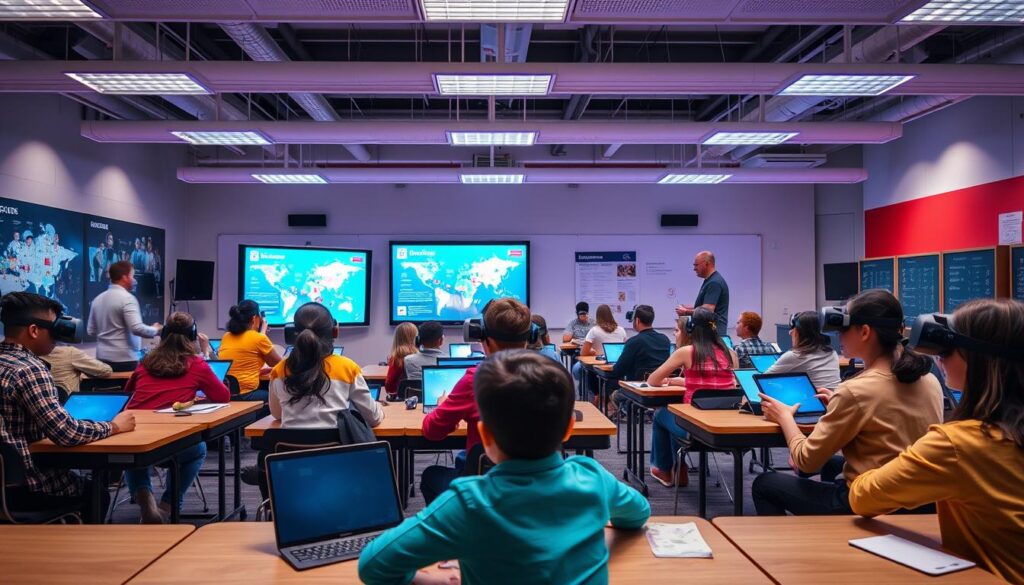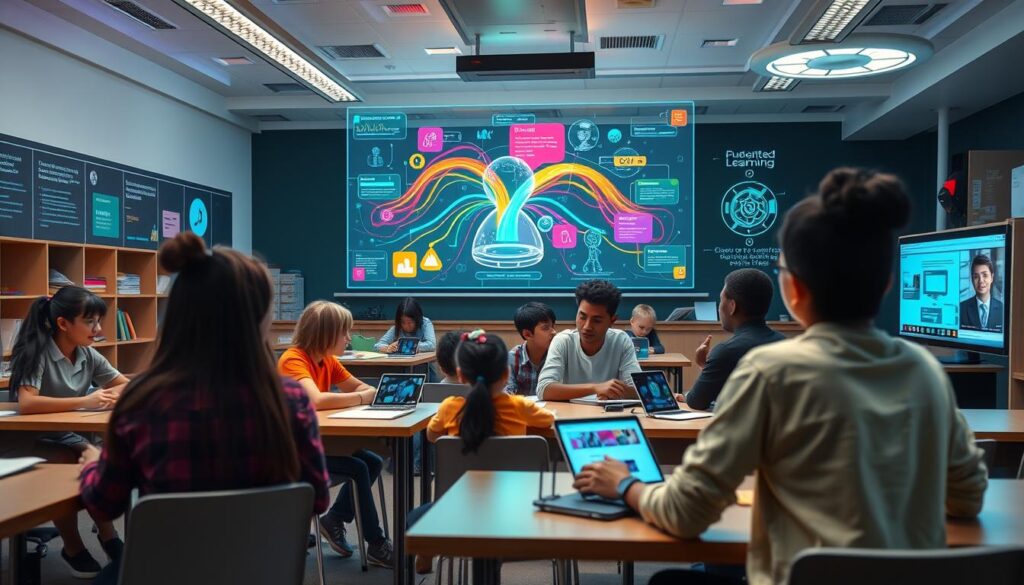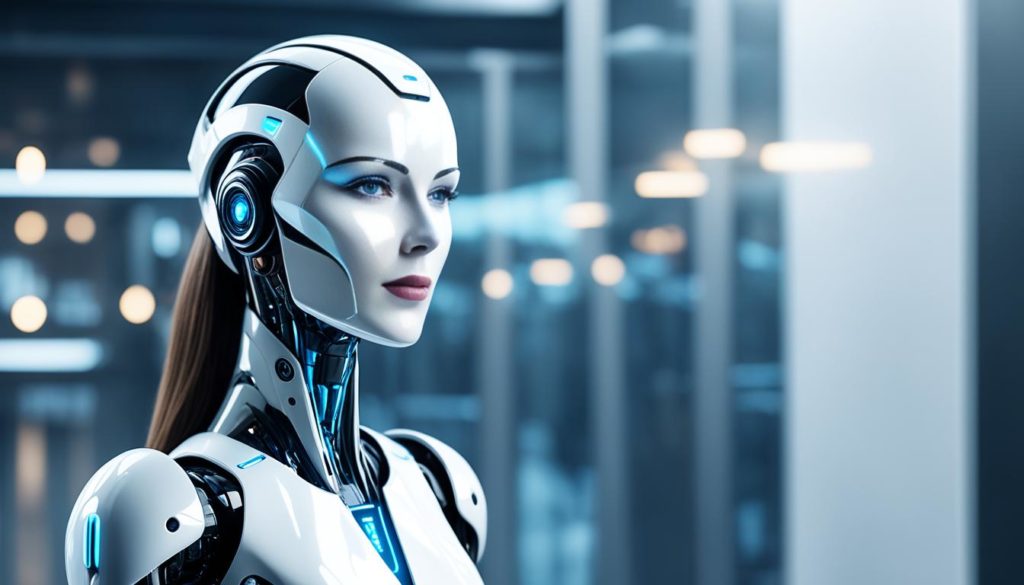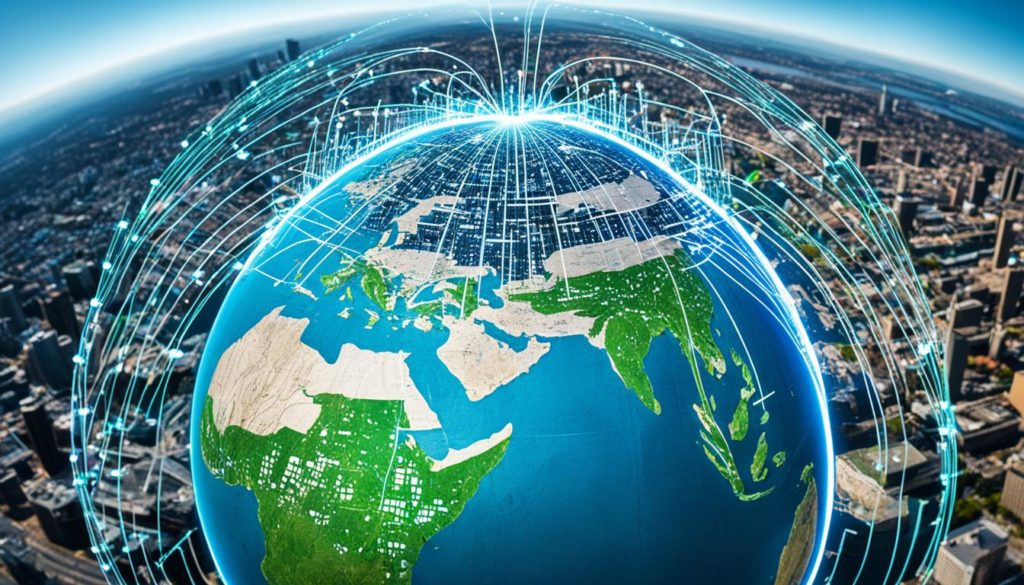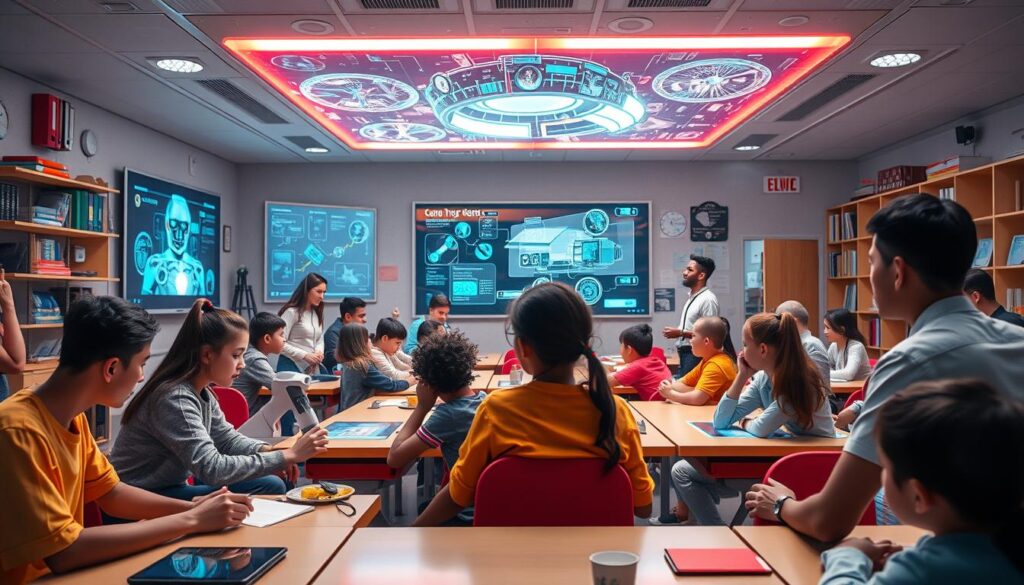
Did you know that using AI in education has made math scores in England among the best? This shows how AI and education can really change learning. In places like sub-Saharan Africa, up to 40% of teachers don’t know the subjects they teach well. AI can help by giving students and teachers personalized learning experiences.
AI’s impact in education started with adaptive math programs in London’s schools in the late ’90s. Dr. Asyia Kazmi from the Bill & Melinda Gates Foundation has seen how machine learning for students helps teachers and boosts student grades. AI is especially helping in countries where many kids can’t read by age 10. It’s all about making education fair and reaching more students.
Key Takeaways
- AI and transformative educational technology boost student achievement, evidenced by England’s top 2% math results.
- 40% of teachers in sub-Saharan Africa lack subject proficiency, underscoring the urgent need for AI support.
- AI-based personalized learning solutions significantly aid low-performing students in sub-Saharan Africa and South Asia.
- AI tutors like Rori in Ghana and Khanmigo in the U.S. enhance student engagement and confidence.
- AI-assisted programs save teachers’ time, improve student engagement, and enhance learning outcomes in countries like Kenya and India.
Introduction: The Impact of AI on Modern Education
Artificial intelligence has changed education in big ways. It brings solutions we never thought possible. Around the world, tech in classrooms helps make learning personal and admin tasks easier.
AI offers personalized learning and quick assessments. A Forbes Advisor survey found US teachers see big improvements thanks to AI.
AI gives teachers tools for real-time feedback and detailed data. It tailors learning to each student’s style, boosting their interest and effort. These tools meet different learning needs, from virtual reality to AI problem-solving.
AI also boosts security with biometric solutions.
AI has also made learning environments more innovative. Teachers get to use big data to make better choices. AI grading saves time, letting teachers focus on helping students.
Chatbots and AI tutors offer one-on-one support, making learning fun and interactive.
AI changes how we teach, too. It helps spot where students need help and gives insights right away. This ensures every student gets what they need to succeed.
AI also helps with online learning, reaching students everywhere. It makes quality education possible for those in remote or hard-to-reach places.
To learn more about AI’s impact on education, check out this article. As we keep innovating, it’s key to use AI wisely. It can make learning more personal, easier for teachers, and accessible to all.
Personalized Learning Experiences Through AI
Artificial Intelligence (AI) is changing education by making it more personal for each student. It helps teachers tailor learning to fit each student’s needs and learning style. This is made possible by neural networks in education, which create adaptive learning systems for every learner.
Adaptive Learning Solutions
In India, Mindspark and in Kenya, EIDU are using AI for educational purposes in new ways. They use student data to create personalized learning paths. This approach has shown big improvements in learning, especially for students who struggle.
AI-powered learning platforms let teachers tailor assignments and assessments. This makes learning more engaging and helps teachers focus on other important tasks.
| AI Solution | Region | Key Features | Benefits |
|---|---|---|---|
| Mindspark | India | Data-driven pathways, personalized feedback, multimodal learning | Improved outcomes, tailored learning |
| EIDU | Kenya | Performance-based difficulty, real-time adjustments | Engages low-performing students, optimizes learning pace |
AI Tutors and Real-Time Feedback
In Ghana, Rori, and in the U.S., Khanmigo, AI tutors are changing how we learn. They offer one-on-one guidance and adjust learning materials based on how well students understand. They use advanced technology to do this.
AI tutors give personalized learning advice based on how students perform and what they’re interested in. They help students feel more confident and engaged. These tools also make sure learning is fair and safe for everyone.
AI integration in education is making teaching better by tailoring it to each student’s needs. By combining AI with human teaching, we can make learning more effective and personal for all.
The Integration of AI in Education
AI is changing how we learn in schools. It’s making classrooms better by helping teachers and students work together more effectively. AI tools and platforms are making learning more efficient and effective.
Changing Classroom Dynamics
AI is making classrooms different. Tools like chatbots and automated grading systems help teachers a lot. They make planning and paperwork easier.
The AI4EDU project is creating tools like Study Buddy and Teacher Workmate. These tools help teachers focus on helping students one-on-one. This is key for good teaching.
Enhanced Learning Materials and Resources
AI is changing how we make and use learning materials. Projects like ‘I’m not a Robot’ create tools for all ages. They help with everything from simple questions to complex tech skills.
The Generation AI project helps teachers and students understand AI. It teaches them to use technology wisely. AI also makes learning materials for all students, no matter their background.
AI-Supported Assessment and Evaluation
AI makes grading and checking work better. Projects like AI4T help teachers learn about AI. They teach them how to use AI tools well.
AI helps find problems early, so teachers can help students quickly. It also makes sure everyone is treated fairly in school. This makes learning better for everyone.
AIware is working to make AI a big part of schools by 2026. It’s helping create new ways to learn and get certified. AI is making learning more exciting and efficient.
In short, AI is making learning better by automating tasks and creating personalized plans. It helps make learning materials and evaluations better too. AI is making schools more inclusive and effective.
For more on AI in schools, check out this article.
Challenges and Considerations in AI and Education
AI has many benefits in education, but there are also challenges and ethical issues. One big problem is that AI models often lack cultural diversity in education AI. This can mean that AI doesn’t fully represent different student voices and experiences. As a result, AI might give out wrong information that looks right, which is a big AI potential risk.
Another big challenge is preventing AI misuse in education. AI technology is getting better fast, like OpenAI’s GPT-3.5 and GPT-4.0. But this also means there’s a risk of AI being used in bad ways. It could make students worry that machines will replace their jobs. Also, AI’s impact on education raises questions about its accuracy and reliability, making students too dependent on it.
AI also has a problem called “hallucination,” where it makes up false information. For example, Google’s AI model is good at empathy but can still make mistakes. We need more research and clear rules to use AI in education the right way.
The table below shows how AI has advanced and what it means for education. It highlights both the good and the bad:
| AI System | Advancement | Implication |
|---|---|---|
| OpenAI GPT Models | From 175 billion parameters to 300 billion tokens | Higher accuracy and functionality, but increased potential risks |
| Microsoft Medical AI Model | Accuracy rate surged from 33% to 85% | Improved health education but risks over-reliance |
| Google’s AI Model | Higher empathy and helpfulness ratings | Enhanced learning experience, yet challenges in ensuring data integrity |
In summary, we need to work together to mitigate AI misuse in education. We must make sure AI helps students learn without taking over their thinking and interaction with others. This is key to making AI a positive force in education, fair and in line with our values.
Conclusion
AI is changing education in big ways. It makes learning better, helps teachers grow, and opens up education to more people. AI tailors lessons to fit each student’s needs and learning style. This is thanks to tools like Khan Academy and Duolingo.
But, we must watch out for the downsides of AI in schools. We need to make sure AI helps everyone equally. It’s important to make sure AI is fair and includes all students.
Looking ahead, we must use AI wisely in schools. We need to make sure AI is open, safe, and fair. This way, AI can help students grow emotionally and academically.
Our goal is to use AI to help all students and teachers. By focusing on fairness and safety, we can make education better for everyone. This will lead to a brighter future for education.
FAQ
How has AI evolved in the educational sector?
AI has grown a lot since the late ’90s. It started with adaptive math programs in London. Dr. Asyia Kazmi from the Bill & Melinda Gates Foundation saw big improvements in student results.
Today, AI is key for personalized learning. It helps make education fairer, especially in poor countries.
What are some notable AI tools used in education worldwide?
Many AI tools are used around the world. For example, Mindspark in India and EIDU in Kenya offer smart learning. AI tutors like Rori in Ghana and Khanmigo in the U.S. use advanced tech to help students learn better.
How does AI personalize learning experiences for students?
AI uses adaptive learning to match content and difficulty to each student. This makes learning better and helps those who struggle. Every student gets a learning plan that fits them.
In what ways does AI support teachers in professional development and classroom management?
AI helps teachers by cutting down on paperwork. This lets them focus more on teaching. Tools like TeachFX and ConveGenius help teachers grow and make classrooms run smoother.
AI also gives insights for better teaching and creates fun learning materials.
What challenges do we face with the integration of AI in education?
AI in schools has its downsides. There’s a lack of diversity in AI models and a risk of spreading wrong info. It can also make students less interested in learning.
We need to use AI wisely, keep researching, and make sure it’s good for everyone.
How does AI enhance classroom learning materials?
AI makes learning materials smarter, like 2D-3D visuals and interactive stuff. These tools make learning fun and engaging. They help students understand tough topics better.
What are the ethical considerations in implementing AI in education?
We must make sure AI is fair and respects students’ privacy. It’s important to follow rules and do thorough research. This way, AI can help education without causing harm.
How can AI bridge the learning equity gap globally?
AI can offer tailored learning to more students, especially in poor areas. It makes education better and more accessible. AI uses data well to help close the gap in education worldwide.
Future App Studios is an award-winning software development & outsourcing company. Our team of experts is ready to craft the solution your company needs.


